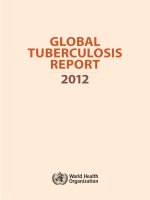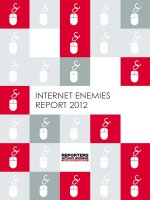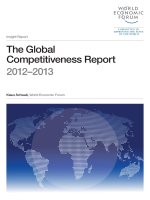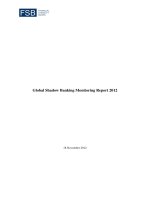AHA antiplatelets PPI report 2012
Bạn đang xem bản rút gọn của tài liệu. Xem và tải ngay bản đầy đủ của tài liệu tại đây (921.28 KB, 7 trang )
Antiplatelet Therapy and Proton Pump Inhibition: Clinician Update
George V. Moukarbel and Deepak L. Bhatt
Circulation. 2012;125:375-380
doi: 10.1161/CIRCULATIONAHA.111.019745
Circulation is published by the American Heart Association, 7272 Greenville Avenue, Dallas, TX 75231
Copyright © 2012 American Heart Association, Inc. All rights reserved.
Print ISSN: 0009-7322. Online ISSN: 1524-4539
The online version of this article, along with updated information and services, is located on the
World Wide Web at:
/>
Permissions: Requests for permissions to reproduce figures, tables, or portions of articles originally published
in Circulation can be obtained via RightsLink, a service of the Copyright Clearance Center, not the Editorial
Office. Once the online version of the published article for which permission is being requested is located,
click Request Permissions in the middle column of the Web page under Services. Further information about
this process is available in the Permissions and Rights Question and Answer document.
Reprints: Information about reprints can be found online at:
/>Subscriptions: Information about subscribing to Circulation is online at:
/>
Downloaded from by guest on June 26, 2014
CLINICIAN UPDATE
Antiplatelet Therapy and Proton Pump Inhibition
Clinician Update
George V. Moukarbel, MD; Deepak L. Bhatt, MD, MPH
A
77-year-old man with history of
diabetes mellitus and coronary
artery disease presented with angina
and evidence of ischemia despite maximal medical therapy. He underwent a
percutaneous coronary intervention
with a drug-eluting stent and was
started on long-term dual antiplatelet
therapy with aspirin and clopidogrel.
His medical history was significant for
an episode of gastrointestinal (GI)
bleeding in the setting of using nonsteroidal antiinflammatory drugs.
Dual antiplatelet therapy, typically
the addition of an ADP receptor antagonist to aspirin, has become the cornerstone of management of patients
with acute coronary syndromes and
after percutaneous coronary intervention. However, along with the reduction of thrombotic outcomes, this therapeutic strategy has the untoward
effect of increasing the risk of bleeding
events, including GI bleeding.1 The
use of gastroprotective strategies, most
notably proton pump inhibitors (PPIs),
has become a widely adopted and recommended practice in this patient population.2 Currently, the most commonly prescribed ADP receptor
antagonist is clopidogrel, a prodrug
that undergoes activation by the cyto-
chrome P450 system, in particular
CYP2C19. The importance of this reaction on the overall platelet inhibitory
effects of clopidogrel is highlighted by
the fact that patients with reducedfunction CYP2C19 alleles exhibit a
reduced response to clopidogrel compared with those with the wild-type
alleles. This finding might translate
into increased risk of adverse events
after acute coronary syndromes and
percutaneous coronary intervention.
Given that PPIs are inhibitors of
CYP2C19, coupled with reports suggesting a clinically significant interaction,3 regulatory agencies issued a cautionary statement advising against the
combined use of PPIs (specifically
omeprazole and esomeprazole) and
clopidogrel.4
Risk of GI Bleeding
With Antiplatelet Therapy
and Effect of
Gastroprotective Strategies
Aspirin causes direct damage to the
gastric epithelium and inhibits prostaglandin production by the gastric mucosa, leading to ulcerations and an
estimated 2-fold increased risk of GI
bleeding with low-dose aspirin alone.1
The risk increases with the additional
use of antiplatelet and antithrombotic
agents, as well as steroidal and nonsteroidal antiinflammatory drugs.1,5 In
patients with heart disease, several
clinical characteristics that confer
added risk of GI bleeding such as
older age, male sex, nonwhite race,
diabetes mellitus, history of alcohol
abuse, heart failure symptoms, and
renal insufficiency can be identified.5 History of ulcers and prior GI
bleeding events are also very important risk factors.6 The risk of bleeding appears to be highest in the early
period after a cardiac event but continues to be present on long-term
follow-up (Figure 1). Gastroprotective strategies to reduce the risk of
GI bleeding in patients taking antiplatelet agents have been tested in
several settings. Both H2 receptor
antagonists and PPIs reduce stomach
acid production, thus allowing gastric ulcers and erosions to heal. Use
of PPIs in patients taking antiplatelet
therapy has been associated with a
significant reduction in the risk of GI
bleeding, ulcers, and erosions in data
from observational and randomized
clinical trials.7–11 Although there is
no large clinical trial with a head-tohead comparison with PPIs, H2 re-
From the Brigham and Women’s Hospital, Harvard Medical School (G.V.M., D.L.B.), and the VA Boston Healthcare System (D.L.B.), Boston, MA.
Correspondence to Deepak L. Bhatt, MD, MPH, FAHA, 1400 VFW PKWY, Boston, MA 02132. E-mail
(Circulation. 2012;125:375-380.)
© 2012 American Heart Association, Inc.
Circulation is available at
DOI: 10.1161/CIRCULATIONAHA.111.019745
Downloaded from />by guest on June 26, 2014
375
376
Circulation
January 17, 2012
nonrandomized studies and could lead
to erroneous association of PPI use
with increased cardiac events.13
PPIs and Aspirin Interaction
Figure 1. Cumulative incidence of gastrointestinal (GI) bleeding during the Valsartan in
Acute Myocardial Infarction (VALIANT) follow-up. The dotted lines represent the 95%
confidence intervals (CIs) of the estimated rate. The monthly incidence rates of GI
bleeding in the first 2 months and between 2 months and 2 years are noted. Reprinted
from Moukarbel et al5 with permission from the publisher. © 2009, European Society of
Cardiology.
ceptor antagonists appear to confer a
more modest protection from GI
events in this setting according to
observational and retrospective studies.10,12 Clinical characteristics can
be used to guide the need for PPIs in
patients taking antiplatelet therapy
(Figure 2).
The weight of the evidence for and
against a clinically significant interaction between antiplatelet agents and
PPIs comes mostly from retrospective
cohort studies or secondary analyses of
randomized controlled trials. Inherent
to the design of such studies, the main
issue is the inability to adjust for residual confounding factors that might
drive the decision to initiate PPI therapy in patients who are at high risk.
Additionally, patients could have been
prescribed PPIs for symptoms that
were misdiagnosed as having a GI
rather than a cardiac origin. Such an
occurrence would be captured in these
Figure 2. Proposed algorithm for use of proton pump inhibitors (PPIs) in patients requiring antiplatelet therapy. GI indicates gastrointestinal; NSAID, nonsteroidal antiinflammatory drug; and GERD, gastroesophageal reflux disease.
There have been recent concerns that
PPIs may interfere with the absorption
and bioavailability of aspirin by altering gastric acidity. Small platelet aggregation studies in patients treated
with low-dose aspirin (75–100 mg)
and concomitant PPI showed opposing
results. 14,15 A propensity score–
matched study in Ϸ20 000 patients
with first myocardial infarction who
were not treated with clopidogrel
showed that treatment with a PPI was
associated with up to 60% increased
risk of cardiovascular death, myocardial infarction, or stroke. There was no
increased risk noted with H2 receptor
antagonists.16 This study had 2 major
specific limitations: it relied on
prescription-filling data from a national registry, and it was uncertain
why these patients were not treated
with dual antiplatelet therapy.
PPIs and Clopidogrel:
Evidence for and
Against a Clinically
Significant Interaction
Only 1 randomized controlled trial,
Clopidogrel and the Optimization of
Gastrointestinal Events (COGENT),
has addressed treatment with PPIs in
patients with coronary artery disease
treated with dual antiplatelet therapy.8
Unfortunately, the trial was stopped
prematurely owing to loss of funding
by the sponsor. Nevertheless, important lessons can be learned from the
results. In the 3761 patients analyzed,
treatment with omeprazole was associated with a significant 66% reduction
in the incidence of GI events at 6
months (Figure 3A). COGENT was
the first large randomized trial to find
that prophylactic PPI use reduced clinical (as opposed to endoscopic) GI end
points. Additionally, there was no difference in the occurrence of cardiovascular events in the 2 groups in the early
period after acute coronary syndromes
or percutaneous coronary intervention,
Downloaded from by guest on June 26, 2014
Moukarbel and Bhatt
Antiplatelets and PPI
377
gested. Pantoprazole and rabeprazole
interfere minimally with the cytochrome P450 system and may potentially not exhibit a similar interaction.19,34 The use of prasugrel instead
of clopidogrel in acute coronary syndromes patients undergoing percutaneous coronary intervention can be considered and has been shown to cause
platelet inhibition even in the face of
clopidogrel nonresponsiveness, albeit
at the expense of increased bleeding.
Newer antiplatelet agents that are not
dependent on the cytochrome P450
isoenzymes such as ticagrelor could be
used in acute coronary syndromes
treated invasively or conservatively.
Administration of the PPI at a different
time than the administration of clopidogrel showed inconsistent results in
the studies that evaluated this strategy.
It is unclear whether the release pharmacokinetics of the particular omeprazole formulation used in COGENT
had any impact on the results of the
trial. Finally, different gastroprotective
drugs such as H2 receptor antagonists
can be used, although they have been
shown to confer a somewhat more
modest protective effect than PPIs.
Figure 3. Efficacy (A) and safety (B) of concomitant proton pump inhibitor (PPI)
(omeprazole) treatment in patients on dual antiplatelet therapy in Clopidogrel and
the Optimization of Gastrointestinal Events (COGENT). A, Kaplan-Meier estimates of
the probability of remaining free of primary gastrointestinal events according to
study group. The event rate for the primary gastrointestinal end point at day 180
was 1.1% in the omeprazole group and 2.9% in the placebo group. B, Kaplan-Meier
estimates of the probability of remaining free of primary cardiovascular events
according to study group. The event rate for the primary cardiovascular end point at
day 180 was 4.9% in the omeprazole group and 5.7% in the placebo group.
Reprinted from Bhatt et al8 with permission from the publisher. © 2010, Massachusetts Medical Society.
when risk of cardiac events would be
expected to be highest (Figure 3B).
The Table summarizes the large nonrandomized published studies examining this issue in different patient populations. These studies vary in terms of
patient inclusion criteria, outcomes
measured, and analysis methods. In
general, studies reporting a positive
association found Ϸ25% to 80% increased risk of cardiovascular events
in patients treated with a PPI in addition to dual antiplatelet therapy. Interestingly, 2 recent meta-analyses of
published studies found no association
between PPI use and mortality.32,33 A
significant association with cardiovascular events was found in observational studies but not in those using
propensity matching or participants of
randomized trials. The presence of significant heterogeneity again indicates
the biased and confounded nature of
the evidence.
Strategies to Avoid the
Effects of an Interaction
Several approaches to circumvent the
potential for significant interference
with clopidogrel effect have been sug-
Conclusions and Summary
of Recommendations
The totality of evidence available to
date does not support a clinically significant impact of any pharmacokinetic or pharmacodynamic interactions
between PPIs and the current widely
used antiplatelet agents. Further evidence that will shed more light on this
matter should come only from randomized clinical trials because new
retrospective studies, no matter how
statistically sound, will only add confusion to the matter. Until then, the
benefit of PPIs in reducing bleeding
events (and treating GI symptoms)
must be factored into decision making
when faced with patients with high GI
bleeding risk requiring antiplatelet
therapy.
Our patient was treated with 20 mg
omeprazole once per day, given the
history of prior GI bleeding events,
other risk factors, and the need for
Downloaded from by guest on June 26, 2014
378
Circulation
January 17, 2012
Table. Summary of Recent Large (n >1000), Nonrandomized Studies Looking at Clinical Evidence of an Interaction Between
Clopidogrel and Proton Pump Inhibitors
Reference (Year)
Design
Population
Treatment, n
Follow-Up
End Point
Results
Pezalla et al17
(2008)
Retrospective
cohort
Heart disease and
or risk factors
PPI, 626; no PPI, 384
1y
MI
OR, 4.3 (95% CI, 2.2–8.4)
Ho et al18 (2009)
Retrospective
cohort
Post-MI, ACS
PPI, 5244; no PPI,
2961
Death, ACS
OR, 1.25 (95% CI, 1.11–1.41)
Nested case-control
Post-MI
Cases, 734 (PPI, 194);
controls, 2057 (PPI,
424)
Death, MI
OR, 1.27 (95% CI, 1.03–1.57)
Kreutz et al20
(2010)
Retrospective
cohort
Poststenting
PPI, 6828; no PPI,
9862
1y
CVA, ACS,
Revascularization,
CV death
HR, 1.51 (95% CI, 1.39–1.64)
Huang et al21
(2010)
Registry
Post-PCI
PPI, 572; no PPI,
2706
6y
ACS; death
HR, 1.23 (95% CI, 1.07–1.41)
and 1.65 (95% CI, 1.35–2.01)
Stockl et al22
(2010)
Retrospective
propensity
matching
Post-MI or stent
PPI, 1033; no PPI,
1033
1y
MI, stent
HR, 1.64 (95% CI, 1.16–2.32)
Van Boxel et al23
(2010)
Retrospective
cohort
Clopidogrel use
PPI, 5734; no PPI,
12 405
2y
Death, ACS, CVA
HR, 1.75 (95% CI, 1.58–1.94)
Registry
Vascular disease
PPI, 519; no PPI, 703
15 mo
MI, CVA, CLI,
death
HR, 1.8 (95% CI, 1.1–2.7)
Post hoc analysis
of RCT
ACS and PCI
PPI, 2257; no PPI,
4,538
Up to 15 mo
MI, CVA, CV
death
No effect
Rassen et al26
(2009)
Retrospective
cohort
ACS or PCI
PPI, 3996; no PPI,
14 569
6 mo
MI, death,
revascularization
No effect
Ray et al7 (2010)
Retrospective
cohort
MI,
revascularization,
UA
PPI, 7593; no PPI,
13 003
1y
MI, CVA, CV
death
No effect
Charlot et al27
(2010)
Registry
MI
PPI, 6753; no PPI,
17 949
1y
MI, CVA, CV
death
No effect
Sarafoff et al28
(2010)
Retrospective
cohort
Poststent
PPI, 698; no PPI,
2640
1 mo
Stent thrombosis
No effect
Tentzeris et al29
(2010)
Registry; propensity
matching
Poststent
PPI, 691; no PPI, 519
1y
Death, ACS
No effect
Banerjee et al13
(2011)
Retrospective
propensity
matching
Post-PCI
PPI, 867; no PPI,
3678
6y
MACE
No effect
Simon et al30
(2011)
Registry
MI
PPI, 1453; no PPI,
900
1y
MI, CVA, Death
No effect
Harjai et al31
(2011)
Registry; propensity
matching
Post-PCI
PPI, 751; no PPI,
1900
6 mo
MACE
No effect
Evidence for
Juurlink et al19
(2009)
Munoz-Torrero
et al24 (2011)
Ϸ3 y
3 mo
Evidence against
O’Donoghue et al25
(2009)
ACS indicates acute coronary syndrome; CI, confidence interval; CLI, chronic limb ischemia; CV, cardiovascular; CVA, cerebrovascular accident; HR, hazard ratio;
MACE, major adverse cardiac events (death, myocardial infarction, revascularization); MI, myocardial infarction; OR, odds ratio; RCT, randomized controlled trial; and
UA, unstable angina.
long-term dual antiplatelet therapy.
For this patient, omeprazole was the
cheapest option because it was on the
hospital formulary. If cost were not an
issue, it would have been reasonable to
initiate therapy with a PPI that has less
effect on CYP2C19 in case future
studies show that the pharmacokinetic
and pharmacodynamic interactions
with clopidogrel translate into clinical
events.
cines Company. He has collaborated with
Takeda and PLx Pharma on research studies.
He was the chair of the COGENT trial. Dr
Moukarbel reports no conflicts.
Disclosures
References
Dr Bhatt receives research grants from Amarin,
AstraZeneca, Bristol-Myers Squibb, Eisai, Ethicon, Medtronic, Sanofi-aventis, and The Medi-
1. Garcia Rodriguez LA, Lin KJ, HernandezDiaz S, Johansson S. Risk of upper gastrointestinal bleeding with low-dose acetylsalicylic
Downloaded from by guest on June 26, 2014
Moukarbel and Bhatt
2.
3.
4.
5.
6.
7.
8.
9.
acid alone and in combination with clopidogrel
and other medications. Circulation. 2011;123:
1108–1115.
Bhatt DL, Scheiman J, Abraham NS,
Antman EM, Chan FK, Furberg CD, Johnson
DA, Mahaffey KW, Quigley EM. ACCF/
ACG/AHA 2008 expert consensus document
on reducing the gastrointestinal risks of antiplatelet therapy and NSAID use: a report of
the American College of Cardiology Foundation Task Force on Clinical Expert Consensus Documents. Circulation. 2008;118:
1894 –1909.
Gilard M, Arnaud B, Cornily JC, Le Gal G,
Lacut K, Le Calvez G, Mansourati J, Mottier
D, Abgrall JF, Boschat J. Influence of
omeprazole on the antiplatelet action of
clopidogrel associated with aspirin: the randomized, double-blind OCLA (Omeprazole
CLopidogrel Aspirin) study. J Am Coll
Cardiol. 2008;51:256 –260.
US Food and Drug Administration.
Follow-up to the January 26, 2009, early
communication about an ongoing safety
review of clopidogrel bisulfate (marketed as
Plavix) and omeprazole (marketed as
Prilosec and Prilosec OTC). November 17,
2009. />PostmarketDrugSafetyInformationforPatient
sandProviders/DrugSafetyInformationfor
HeathcareProfessionals/ucm190784.htm.
Accessed July 15, 2011.
Moukarbel GV, Signorovitch JE, Pfeffer
MA, McMurray JJ, White HD, Maggioni
AP, Velazquez EJ, Califf RM, Scheiman JM,
Solomon SD. Gastrointestinal bleeding in
high risk survivors of myocardial infarction:
the VALIANT Trial. Eur Heart J. 2009;30:
2226 –2232.
Abraham NS, Hlatky MA, Antman EM,
Bhatt DL, Bjorkman DJ, Clark CB, Furberg
CD, Johnson DA, Kahi CJ, Laine L,
Mahaffey KW, Quigley EM, Scheiman J,
Sperling LS, Tomaselli GF. ACCF/
ACG/AHA 2010 expert consensus document
on the concomitant use of proton pump inhibitors and thienopyridines: a focused
update of the ACCF/ACG/AHA 2008 expert
consensus document on reducing the gastrointestinal risks of antiplatelet therapy and
NSAID use: a report of the American
College of Cardiology Foundation Task
Force on Expert Consensus Documents.
Circulation. 2010;122:2619 –2633.
Ray WA, Murray KT, Griffin MR, Chung
CP, Smalley WE, Hall K, Daugherty JR,
Kaltenbach LA, Stein CM. Outcomes with
concurrent use of clopidogrel and
proton-pump inhibitors: a cohort study. Ann
Intern Med. 2010;152:337–345.
Bhatt DL, Cryer BL, Contant CF, Cohen M,
Lanas A, Schnitzer TJ, Shook TL, Lapuerta
P, Goldsmith MA, Laine L, Scirica BM,
Murphy SA, Cannon CP. Clopidogrel with
or without omeprazole in coronary artery
disease. N Engl J Med. 2010;363:
1909 –1917.
Lanas A, Garcia-Rodriguez LA, Arroyo MT,
Bujanda L, Gomollon F, Forne M, Aleman
S, Nicolas D, Feu F, Gonzalez-Perez A,
Borda A, Castro M, Poveda MJ, Arenas J.
10.
11.
12.
13.
14.
15.
16.
17.
18.
19.
20.
Effect of antisecretory drugs and nitrates on
the risk of ulcer bleeding associated with
nonsteroidal anti-inflammatory drugs, antiplatelet agents, and anticoagulants. Am J
Gastroenterol. 2007;102:507–515.
Lin KJ, Hernandez-Diaz S, Garcia Rodriguez
LA. Acid suppressants reduce risk of gastrointestinal bleeding in patients on antithrombotic or
anti-inflammatory therapy. Gastroenterology.
2011;141:71–79.
Scheiman JM, Devereaux PJ, Herlitz J,
Katelaris PH, Lanas A, Veldhuyzen van
Zanten S, Naucler E, Svedberg LE. Prevention of peptic ulcers with esomeprazole
in patients at risk of ulcer development
treated with low-dose acetylsalicylic acid: a
randomised, controlled trial (OBERON).
Heart. 2011;97:797– 802.
Ng FH, Lam KF, Wong SY, Chang CM, Lau
YK, Yuen WC, Chu WM, Wong BC. Upper
gastrointestinal bleeding in patients with
aspirin and clopidogrel co-therapy.
Digestion. 2008;77:173–177.
Banerjee S, Weideman RA, Weideman MW,
Little BB, Kelly KC, Gunter JT, Tortorice
KL, Shank M, Cryer B, Reilly RF, Rao SV,
Kastrati A, de Lemos JA, Brilakis ES, Bhatt
DL. Effect of concomitant use of clopidogrel
and proton pump inhibitors after percutaneous coronary intervention. Am J Cardiol.
2011;107:871– 878.
Adamopoulos AB, Sakizlis GN, Nasothimiou
EG, Anastasopoulou I, Anastasakou E, Kotsi
P, Karafoulidou A, Stergiou GS. Do proton
pump inhibitors attenuate the effect of aspirin
on platelet aggregation? A randomized
crossover study. J Cardiovasc Pharmacol.
2009;54:163–168.
Wurtz M, Grove EL, Kristensen SD, Hvas
AM. The antiplatelet effect of aspirin is
reduced by proton pump inhibitors in
patients with coronary artery disease. Heart.
2010;96:368 –371.
Charlot M, Grove EL, Hansen PR, Olesen
JB, Ahlehoff O, Selmer C, Lindhardsen J,
Madsen JK, Kober L, Torp-Pedersen C,
Gislason GH. Proton pump inhibitor use and
risk of adverse cardiovascular events in
aspirin treated patients with first time myocardial infarction: nationwide propensity
score matched study. BMJ. 2011;342:d2690.
Pezalla E, Day D, Pulliadath I. Initial
assessment of clinical impact of a drug interaction between clopidogrel and proton pump
inhibitors. J Am Coll Cardiol. 2008;52:
1038–1039; author reply 1039.
Ho PM, Maddox TM, Wang L, Fihn SD,
Jesse RL, Peterson ED, Rumsfeld JS. Risk of
adverse outcomes associated with concomitant use of clopidogrel and proton pump
inhibitors following acute coronary
syndrome. JAMA. 2009;301:937–944.
Juurlink DN, Gomes T, Ko DT, Szmitko PE,
Austin PC, Tu JV, Henry DA, Kopp A,
Mamdani MM. A population-based study of
the drug interaction between proton pump
inhibitors and clopidogrel. CMAJ. 2009;180:
713–718.
Kreutz RP, Stanek EJ, Aubert R, Yao J,
Breall JA, Desta Z, Skaar TC, Teagarden JR,
Frueh FW, Epstein RS, Flockhart DA.
Antiplatelets and PPI
21.
22.
23.
24.
25.
26.
27.
28.
29.
30.
379
Impact of proton pump inhibitors on the
effectiveness of clopidogrel after coronary
stent placement: the Clopidogrel Medco
Outcomes study. Pharmacotherapy. 2010;
30:787–796.
Huang CC, Chen YC, Leu HB, Chen TJ, Lin
SJ, Chan WL, Chen JW. Risk of adverse
outcomes in Taiwan associated with concomitant use of clopidogrel and proton pump
inhibitors in patients who received percutaneous coronary intervention. Am J Cardiol.
2010;105:1705–1709.
Stockl KM, Le L, Zakharyan A, Harada AS,
Solow BK, Addiego JE, Ramsey S. Risk of
rehospitalization for patients using clopidogrel with a proton pump inhibitor. Arch
Intern Med. 2010;170:704 –710.
van Boxel OS, van Oijen MG, Hagenaars
MP, Smout AJ, Siersema PD. Cardiovascular and gastrointestinal outcomes in
clopidogrel users on proton pump inhibitors:
results of a large Dutch cohort study. Am J
Gastroenterol. 2010;105:2430 –2437.
Munoz-Torrero JF, Escudero D, Suarez C,
Sanclemente C, Pascual MT, Zamorano J,
Trujillo-Santos J, Monreal M. Concomitant
use of proton pump inhibitors and clopidogrel in patients with coronary, cerebrovascular, or peripheral artery disease in the
Factores de Riesgo y ENfermedad Arterial
(FRENA) registry. J Cardiovasc Pharmacol.
2011;57:13–19.
O’Donoghue ML, Braunwald E, Antman
EM, Murphy SA, Bates ER, Rozenman Y,
Michelson AD, Hautvast RW, Ver Lee PN,
Close SL, Shen L, Mega JL, Sabatine MS,
Wiviott SD. Pharmacodynamic effect and
clinical efficacy of clopidogrel and prasugrel
with or without a proton-pump inhibitor: an
analysis of two randomised trials. Lancet.
2009;374:989 –997.
Rassen JA, Choudhry NK, Avorn J, Schneeweiss S. Cardiovascular outcomes and mortality in patients using clopidogrel with proton
pump inhibitors after percutaneous coronary
intervention or acute coronary syndrome.
Circulation. 2009;120:2322–2329.
Charlot M, Ahlehoff O, Norgaard ML, Jorgensen CH, Sorensen R, Abildstrom SZ,
Hansen PR, Madsen JK, Kober L, TorpPedersen C, Gislason G. Proton-pump inhibitors are associated with increased cardiovascular risk independent of clopidogrel use: a
nationwide cohort study. Ann Intern Med.
2010;153:378 –386.
Sarafoff N, Sibbing D, Sonntag U, Ellert J,
Schulz S, Byrne RA, Mehilli J, Schomig A,
Kastrati A. Risk of drug-eluting stent
thrombosis in patients receiving proton
pump inhibitors. Thromb Haemost. 2010;
104:626 – 632.
Tentzeris I, Jarai R, Farhan S, Brozovic I,
Smetana P, Geppert A, Wojta J, SillerMatula J, Huber K. Impact of concomitant
treatment with proton pump inhibitors and
clopidogrel on clinical outcome in patients
after coronary stent implantation. Thromb
Haemost. 2010;104:1211–1218.
Simon T, Steg PG, Gilard M, Blanchard D,
Bonello L, Hanssen M, Lardoux H, Coste P,
Lefevre T, Drouet E, Mulak G, Bataille V,
Downloaded from by guest on June 26, 2014
380
Circulation
January 17, 2012
Ferrieres J, Verstuyft C, Danchin N. Clinical
events as a function of proton pump inhibitor
use, clopidogrel use, and cytochrome P450
2C19 genotype in a large nationwide cohort of
acute myocardial infarction: results from the
French Registry of Acute ST-Elevation and
Non-ST-Elevation Myocardial Infarction
(FAST-MI) registry. Circulation. 2011;123:
474–482.
31. Harjai KJ, Shenoy C, Orshaw P, Usmani S,
Boura J, Mehta RH. Clinical outcomes in
patients with the concomitant use of clopi-
dogrel and proton pump inhibitors after percutaneous coronary intervention: an analysis
from the Guthrie Health Off-Label Stent
(GHOST) investigators. Circ Cardiovasc
Interv. 2011;4:162–170.
32. Kwok CS, Loke YK. Meta-analysis: the
effects of proton pump inhibitors on cardiovascular events and mortality in patients
receiving clopidogrel. Aliment Pharmacol
Ther. 2010;31:810 – 823.
33. Siller-Matula JM, Jilma B, Schror K, Christ G,
Huber K. Effect of proton pump inhibitors on
clinical outcome in patients treated with clopidogrel: a systematic review and meta-analysis.
J Thromb Haemost. 2010;8:2624–2641.
34. Ferreiro JL, Ueno M, Tomasello SD,
Capodanno D, Desai B, Dharmashankar K,
Seecheran N, Kodali MK, Darlington A,
Pham JP, Tello-Montoliu A, Charlton RK,
Bass TA, Angiolillo DJ. Pharmacodynamic
evaluation of pantoprazole therapy on clopidogrel effects: results of a prospective, randomized, crossover study. Circ Cardiovasc
Interv. 2011;4:273–279.
Downloaded from by guest on June 26, 2014









